1. Historical study of the evolution of the fin in surfing: genes to maintain.
2. Theoretical study of hydrodynamics, mechanics and kinematics of surf fins.
- Advantages of the system ADAC.
- Analogy with the types of turns in skiing or Snowboarding.
- Influences of the camber and the angle of attack of hydrodynamic profiles.
- Influence ADAC on the drag resistance of surf fins.
- Influence ADAC on the lift of surf fins.
- Influence ADAC on the efficiency range and stall.
- Influence ADAC on acceleration of surf.
- Influence ADAC on hanging rail by limiting cant effect.
- Influence ADAC on reducing eddy losses (winglet effect).
- ADAC Safety surf fins (anti cuts fins).
1:Historical study of the evolution of the fin in surfing: genes to maintain:
the 11 basic genes:
Before going further in the description of the system ADAC fins,and demonstrate the real contribution that it provides to technical state, check that the system integrates the best of what has been done in its genes. Since 1934 (Tom Blake), the fins designers brings up various forms with different objectives. We will mention here only basic genes in the genealogy of the fin, as dozens of models deserve to be mentioned for their participation in this development. We put aside the purely aesthetic factor, which remains an important argument in an environment where the fashion effect has strong anchors. For a more detailed study of the history of the fin, I invite you to consult the page :https://www.surfresearch.com.au/f.html

Gene n°1:
style="margin-left:35.4pt">In the beginning, there were the waves .... and instinct:
style="margin-left:35.4pt">The need creates the function of the fin instinctively, by varying the shapes of our hands to guide us in the wave. No historical track of the inventor, perhaps we should be looking at prehistoric level, and certainly beyond, in our genetic memory...or closer to us, in the sensation of the present moment.
Gene n°1: Continual variation of the shape of the fin depending on the environment.Gene n°2:
style="margin-left:35.4pt">In history, every civilization of fishermen, has developed its own experience of waves and a way to surf it. So we will not be debating here in anticipation of the discovery because the instinct of surfing is universal. Travel narratives in West Africa (1600) report the agility of paddlers in waves, in this case, the oar is used as fin that is oriented to direct the boat in the wave

Gene n°2: Variations in the angle of attack of the fin as needed
Gene n°3:
The first surfboards observed during Cook's voyages (1769) to sandwich islands describe long boards without fins, and the first photographs of surfing (1890)


show us a shape "Alaia" without fins .
Surfboards will remain long without fins, rail is the only way to hang in the wave:

Gène n°3: hung on the rail, straight line without transversal skid, our fin should not curbing us .
Gene n°4:
But the need to take support to change the trajectory without skidding (Slide) is real, and to direct their longboards without fins, the surfeurs (1930-1940) briefly dip his foot in the water to turn the board...We can attribute the invention of the surf fin to Tom Blake (1934), Salute this brilliant surfer who embodies the creative spirit of shaper / surfer:

The implementation of these fins, revolutionized surfing by enabling figures, previously impossible, it helps to stabilize the trajectory, and create a rear pivot to turn and change direction.. But despite its great efficiency, this innovation proposed by Blake in 1934, take time to be adopted, due to its relative difficulty of implementation, and the danger it represents, in the eyes of surfers of that time.

Gene n°4 : The bearing point and the pivot for the curve , but we will retain too, an advanced technology, must include safety and ease of integration to be shared.
Gene n°5:
From 1935-1960 the height of the fin keeps increasing,the fulcrum is more effective and enables turns increasingly tight ,the radicality of cut back and bottom turn are linked to this development:
 1935-1960:
1935-1960:

Gene n°5 : The importance of the support surface
Gene n°6:
in the 60s, The development of new materials allow larger aspect ratios, and security is starting to become an argument, we note in 1960 POPOUT which is intended to be removed upon impact:

Gene n°7:
Around 1964 when the Twin (2 fins) spreads, Greenought test Twin drifts, bringing together systematically, as he gets efficiency,He ended up so closer, he ascertains that only one drift, well sized is more effective! Not the twin is not dead and multi fin still has bright future, but let us remember that more is not necessarily better!

Gene n°7 : A good fin is worth two that contradict !
Gene n°8:
Greenought develops singles fins of high aspect ratio: He introduces the rake (angle backwards) and flexibility combination, permits deformation of the geometry under pressure, a soft feel and fluidity in maneuvers is thus introduced !


Gene n°8: variable geometry according to the effort!
Gene n°9 :
In 1977 Cundith work on the structure, combined with the material used to manage the flexibility of the fin:

Gène n°9: travail de la structure
Gene n°10:
In 1998, Swivel Fin introduces an adjustable incidence concept that is certainly the result of a more scientific approach to the hydrodynamic performance of the foils according to their attack angle

Gene n°10: the importance of the attack angleand the possibility of adaptation !
Gene n°11:
Around 1984 to 1986 appear winglets end fin, inspired by aeronautics, they help to reduce eddy losses at the tip of fin,The winglet provides gain for the fins whose center of lift near the edge generates a lot of losses,beware not to unnecessarily increase the drag area...

Gene n°11: reduce eddy losses when the concentration of lift is high.
Also see how some problem areas revealed by the analysis of the hydrodynamic operation of the fin, has been erased by the innovative gene ADAC: (Adaptive Attack Camber System)...
2: Theoretical study of hydrodynamics, mechanics and kinematics of surf fins :
The specifications of a fin is particularly complex as it varies, depending, of surfer, the board and the wave in constant transformation.The conditions encountered in the trajectory of a single wave: acceleration, hangs, dynamic curves..., are all specific instants, where function of the fin varies and sometimes even oppose. This dynamics evolutionary of the specifications, highlights the major strength of the system ADAC reactive structure :
Advantages of the system ADAC:
- automatic and linked progressive variation of the camber and the angle of attack generating a constant optimization of the lift/drag ratio.
- - Dynamic Parallelism fins, reducing drag, and providing a permanent synchronization of performance of each fin.
- Ultra rapid increase in lift force at low angles of attack .(120 newtons for 10 degres at 14m/s)
- Hang up only on demand through a variable camber, controlled depending on the downforce generated by the surfer .(negative and positive progressive variation in the camber from 0 to 35%)
- Acceleration pumping effect, with a projection of all components of transverse movement, transformed into acceleration. Bilateral orientation (45 °) of the lift force, transforming every lateral components into propulsive force
- -Thrust production through the use of the undulatory motion of the paddle phases.
- -High position of the centers of lift finsfavoring grip the rail, by limiting cant effect.
- Feathering in the straight paths of the phases of acceleration with almost no residual drag (0,7 newtons at 4m/s)
- Structure biomechanical multi-material ensuring durability, elasticity and safety due to the flexibility of the tapered portions thereby protecting from risk of cuts.
- 5 different materials combined in an aeronautical structure, form a chain link drive, allow a controlled elastic deformation and forming at winglet effect lip
- -Axis of rotation at the spine, generated by the automatic incidence variation. This positioning of the imaginary axis of rotation allows a more balanced Surf position and engaged in maneuvering, inducing a more horizontal gliding board, thus a better preservation of speed.
- A unique and instinctive feeling of the presence of the fin due to its dynamic response to the pulses, which provides a real experience of intuitive and natural trajectories!
One can compare the curves, with static surf fins and fin system equipped with the ADAC, to ski curves, skidded or cut:
- At a higher technical level, the skid in turn has major drawbacks:
- It is not suitable for high speed cornering. Indeed, the centrifugal force is such that the rider can not remain in its path.
- It does not allow a sufficiently accurate control of the board.
- It does not turn into a small space.
- It is an important source of speed loss.
- positions of the body too far back for performing a fast velocity recovery.
- Cutting curves, enables precise driving in high speed curve. The rate of loss is very low. In addition, support remains centered during cornering control phase and control can be very effective and intuitive. Body position remains centered so the boost is immediate.
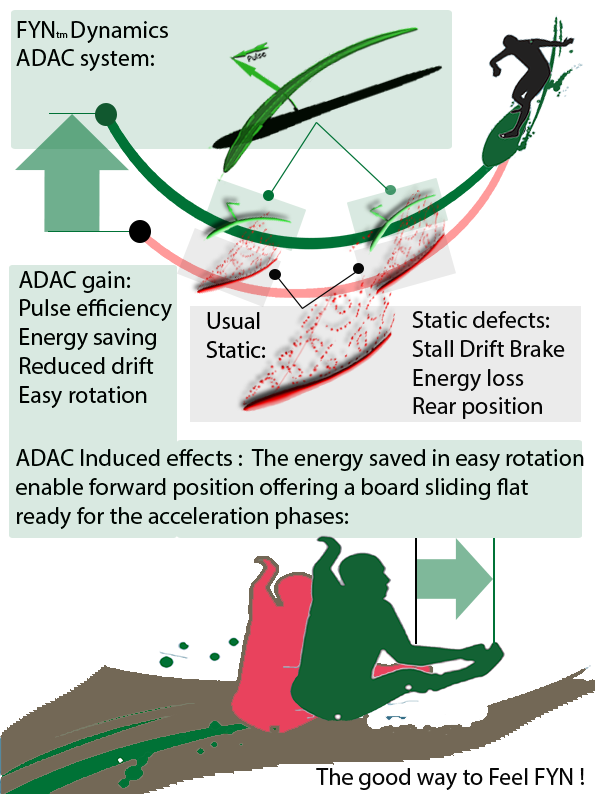
But for technicians or scientists sensitive to quantified arguments, let's be more precise, and enter the heart of the hydrodynamic problem:
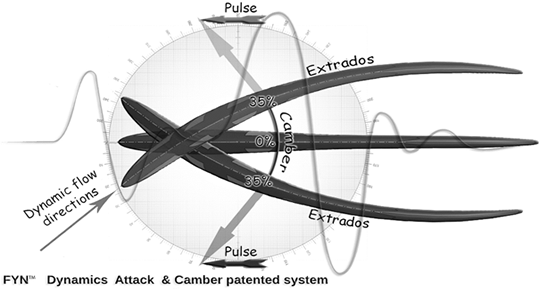
( fig 1)
The theoretical performance of the best hydrodynamic profiles are known and listed by the experts in databases (See Heliciel software), and we know how the drag and lift performance vary depending incidence, cambers and speeds .- Symmetrical profiles of surf fins:

( fig 2.1 : Symmetrical profiles of surf fins)
Which here (Fig 2.2) lift curve / drag as a function of incidence variation at a given speed for a fin with this profile:
( fig 2.2:Symmetrical profiles performances)
- cambered profiles of surf fins:
![]()
( fig 2.3:cambered profiles of surf fins)
Which here (Fig2. 4) lift curve / drag as a function of incidence variation at a given speed for a fin with this profile:
( fig 2.4: cambered profiles of surf fins performances )
Presentation of curves (Figure 2.2 and 2.4); green drag (Newtons), blue lift (Newton) black (lift / drag ratio), with horizontal axis giving variation of the relative incidence from 0 to 90 degrees.
Comparing the curves of these two profiles (Fig 2.1 and 2.3) show a drag force (green curves) very low (0.7 Newtons) to zero incidence for symmetric profile (Figure 2.2), while an cambered profile (Fig 2.4), generates a 8 newtons drag.
In straight path, thus there is a clear interest in using a symmetrical profile. For an element of judgment, consider the two fins opposite a twin, with an angle of 4 degrees of incidence determined by the shaper: 9+9=18 newtons of drag, almost 2 kilos to push at the end of legs. ADAC SYSTEM aligns fins to zero incidence and removes the camber when the path is parallel to the axis of the board it also keeps the parallelism of the fins at any angle), So a delta of 18 -1.4 = 16.6 newtons deleted drag.
A cambered profile generates a significant lift force even at low angles (Fig 2.4), any slippage or lateral component of movement, transforming the profile of ADAC SYSTEM in cambered profile that generates more lift, so more camber, so more lift ... The feedback effect of the grip loop, generates a recovery path, almost immediate, which makes it very reactive system and reduces time spent in adjusting trajectory. In our example a symmetrical fin (Figure 2.2) must be placed at 40 degrees incidence to generate lift 120 newtons , while the variable camber fin of ADAC SYSTEM already offers 120 newtons at 10 degrees (Fig 2.4) and up to 160 newton at 15 degrees. Therefore a sliding range of the rear of the board 4 times less, with ADAC SYSTEM. The camber variation of ADAC SYSTEM, therefore combines the performance of a symmetrical profile, which are optimum at the straight trajectories or very low incidence,with the performance of various variable camber profiles. .Beyond about 30 degrees of incidence, whatever the shape of the profile, a hydrodynamic stall phenomenon suddenly deteriorates, the lift of a classic fin (fig 2.2 et 2.4).
The adaptability of the angle of incidence of ADAC system ( fig 1) keeps an optimal angle of incidence, by a pivoting of the profile in relation to the path of the fluid, thereby maintaining effective attack angles pushing back the stall effect, even in the tightest curves.
The variation in incidence and camber is programmed "mechanically" by controlled elastic deformation in a structure (patented aeronautical technology) forming a loop link drive: the kinematic chain The ADAC SYSTEM reacts to lateral forces when the trajectory includes a drift component . The kinematics of ADAC SYSTEM causes the tilting of the direction of the lift of the fin forward, generating a propulsive component producing the acceleration. This projection lift generated by ADAC SYSTEM brings two major advantages:
Creating a natural aptitude of production speed at alternative lateral movements, particularly instinctive (pumping) like a dolphin tail movement or fish.
Production acceleration when turning, providing a dynamic trajectory, opening prospects unattainable figures without this boost.
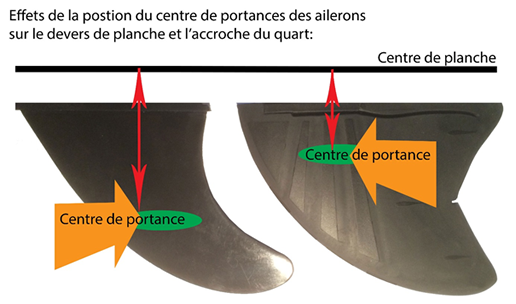
A pressure center near the board limits its slope and the effort to hook the rail into the wave. Long fins unfortunately increase cant effect tends to reverse the board when the support is important. The ADAC system provides the drive and 70% additional thrust through its leading edge and its dynamic camber, while keeping a pressure center, very close to the board, to reduce the tilt.
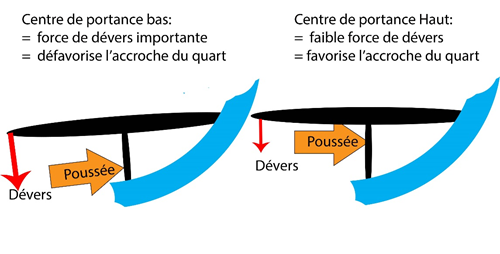

3: Intuitive experience & Search of natural sensations:
The biomechanical structure ADAC SYSTEM generates an intuitive experience through hydrodynamic impulses in phase with the organic logic.
Many test sessions, fueled optimization pulsations accelerations, giving rhythm to the trajectories.The addictive reactivity obtained results from the patented structural kinematics ADAC SYSTEM
The fluidity of instinctive movements of the body in curves, generates the expression of the natural marine instinct.
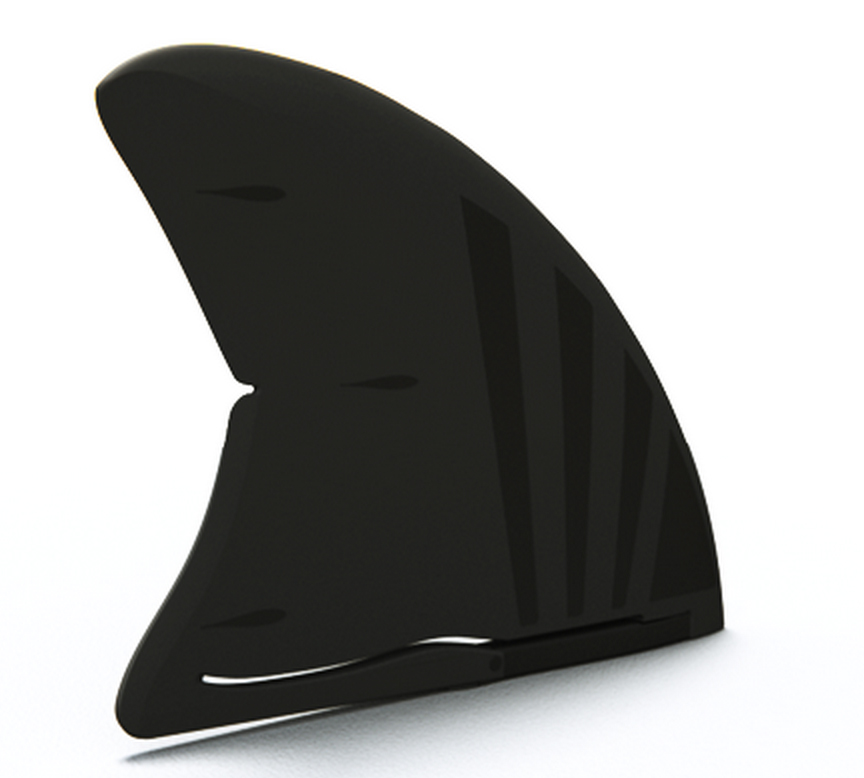 To confirm that surfers are interested for, hydrodynamics and its arguments, I invite you to send me your comments: _contact@mecaflux.com_
JF Iglesias.
To learn more about surfing fins FYN : https://fynsurf.com/
To confirm that surfers are interested for, hydrodynamics and its arguments, I invite you to send me your comments: _contact@mecaflux.com_
JF Iglesias.
To learn more about surfing fins FYN : https://fynsurf.com/
Contacts legal licenses and patents ADAC::
- Europe/France patent attorney :
- USA patent attorney:
CIONCA Law Group P.C. Irvine, CALIFORNIE 92614
Cabinet Gasquet 74000 Annecy France